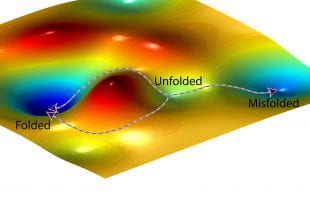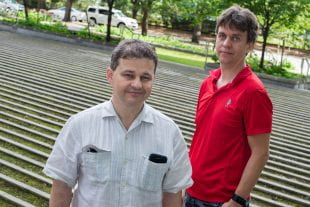Jeff Falk
713-348-6775
jfalk@rice.edu
Jade Boyd
713-348-6778
jadeboyd@rice.edu
Hidden symmetry found in chemical kinetic equations
Rice University discovery has implications for drug design, genetics, more
HOUSTON — (April 30, 2020) — Rice University researchers have discovered a hidden symmetry in the chemical kinetic equations scientists have long used to model and study many of the chemical processes essential for life.
The find has implications for drug design, genetics and biomedical research and is described in a study published this month in the Proceedings of the National Academy of Sciences. To illustrate the biological ramifications, study co-authors Oleg Igoshin, Anatoly Kolomeisky and Joel Mallory of Rice’s Center for Theoretical Biological Physics (CTBP) used three wide-ranging examples: protein folding, enzyme catalysis and motor protein efficiency.
In each case, the researchers demonstrated that a simple mathematical ratio shows that the likelihood of errors is controlled by kinetics rather than thermodynamics.
“It could be a protein folding into the correct versus the incorrect conformation, an enzyme incorporating the right versus the wrong amino acid into the polypeptide chain, or a motor protein mistakenly stepping backward instead of going forward,” said Igoshin, a CTBP investigator and professor of bioengineering at Rice. “All of those properties can be expressed as a ratio of two steady-state fluxes, and we found that biological properties expressed in these terms are under kinetic control.”
The protein-folding example illustrates the implications for drug design. All proteins fold into a characteristic shape, and a fraction misfold into the wrong shape. Protein misfolding has been implicated in some heritable genetic disorders and diseases, and drugmakers are interested in making drugs that can reduce the chances of proteins misfolding.

An artist’s representation of a free-energy landscape and two possible paths a protein might follow (left) to fold correctly and a third path (right) that leads to a misfolded state. (Image courtesy of O. Igoshin/Rice University)
Before it folds, a protein has energy, like a ball sitting atop a hill. Folding is the downhill run from this high-energy starting point to the place where the ball stops rolling. Chemists often use a visual aid called a “free-energy landscape” to chart energy levels in chemical reactions. The landscape looks like a mountain range with peaks and valleys, and the downhill run from a protein’s unfolded starting point to its fully folded finishing point can look like a mountain road that winds through a series of valleys. Even if one town along the road is lower in elevation, a traveler might have to climb hills to get from one valley to the next on the way downhill.
“We’ve shown it’s the barriers, the high points between valleys, that determine these ratios,” Igoshin said. “The depths of the valleys don’t matter.
“If you want to get a drug that will help a protein fold correctly, for example, our prediction is that the drug must be able to reduce a barrier along the folding pathway,” he said. “If it only affects the valleys, say by improving the stability of some intermediate conformations along the folding pathway, it won’t change the ratio of times the protein folds correctly versus incorrectly.”
Igoshin said the work stemmed from a 2017 study where he, Kolomeisky and former CTBP postdoctoral researcher Kinshuk Banerjee showed that the accuracy of enzymatic catalysis was kinetically controlled. Igoshin described the discovery as a “kind of underlying symmetry of equations.”
“If you look at the ratios of fluxes, you get this interesting cancellation, and all the terms that have to do with these values cancel out, and you get the invariance,” he said. “When we first got this result, it seemed counterintuitive to us. Then, we were not sure if it was a coincidence, because in the previous paper we showed it for only two particular kinetic schemes. Now Joel’s work has shown it can be generalized to this wide range of systems.”
Igoshin said the symmetry “wasn’t that hard to prove, but no one noticed it before.”
“I think it is a very interesting physical result that has big implications in biology,” he said. “It could help define the limits on what is possible in terms of controlling and optimizing system-level properties in many biological processes.”
Kolomeisky is a CTBP investigator, a professor of chemistry and of chemical and biomolecular engineering and chair of Rice’s Department of Chemistry. Mallory is a postdoctoral research associate at CTBP.
The research was supported by the National Science Foundation (PHY-1427654, CHE-1664218, MCB-1941106) and the Welch Foundation (C-1559, C-1995).
-30-
Links and resources:
The DOI of the PNAS paper is: 10.1073/pnas.1920873117
A copy of the paper is available at: https://doi.org/10.1073/pnas.1920873117
High-resolution IMAGES are available for download at:
https://news2.rice.edu/files/2020/04/0504_OPTIM-oiak-lg.jpg
CAPTION: Anatoly Kolomeisky, left, and Oleg Igoshin. (Credit: Jeff Fitlow/Rice University)
https://news2.rice.edu/files/2020/04/0504_OPTIM-fig-lg.jpg
CAPTION: An artist’s representation of a free-energy landscape and two possible paths a protein might follow (left) to fold correctly and a third path (right) that leads to a misfolded state. (Image courtesy of O. Igoshin/Rice University)
This release can be found online at news.rice.edu.
Follow Rice News and Media Relations via Twitter @RiceUNews.
Located on a 300-acre forested campus in Houston, Rice University is consistently ranked among the nation’s top 20 universities by U.S. News & World Report. Rice has highly respected schools of Architecture, Business, Continuing Studies, Engineering, Humanities, Music, Natural Sciences and Social Sciences and is home to the Baker Institute for Public Policy. With 3,962 undergraduates and 3,027 graduate students, Rice’s undergraduate student-to-faculty ratio is just under 6-to-1. Its residential college system builds close-knit communities and lifelong friendships, just one reason why Rice is ranked No. 1 for lots of race/class interaction and No. 4 for quality of life by the Princeton Review. Rice is also rated as a best value among private universities by Kiplinger’s Personal Finance.


